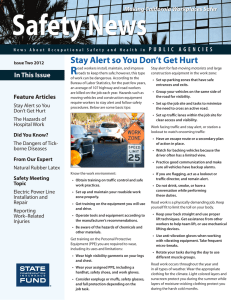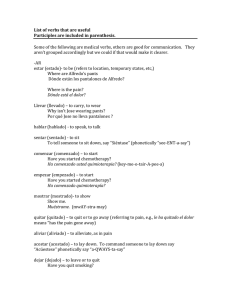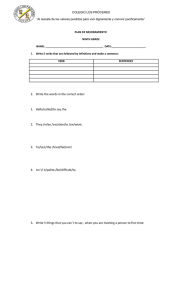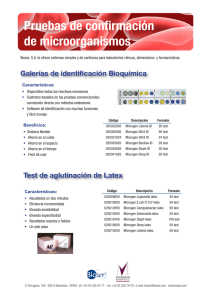Preventing Burn Injuries–A Hot Topic
Anuncio
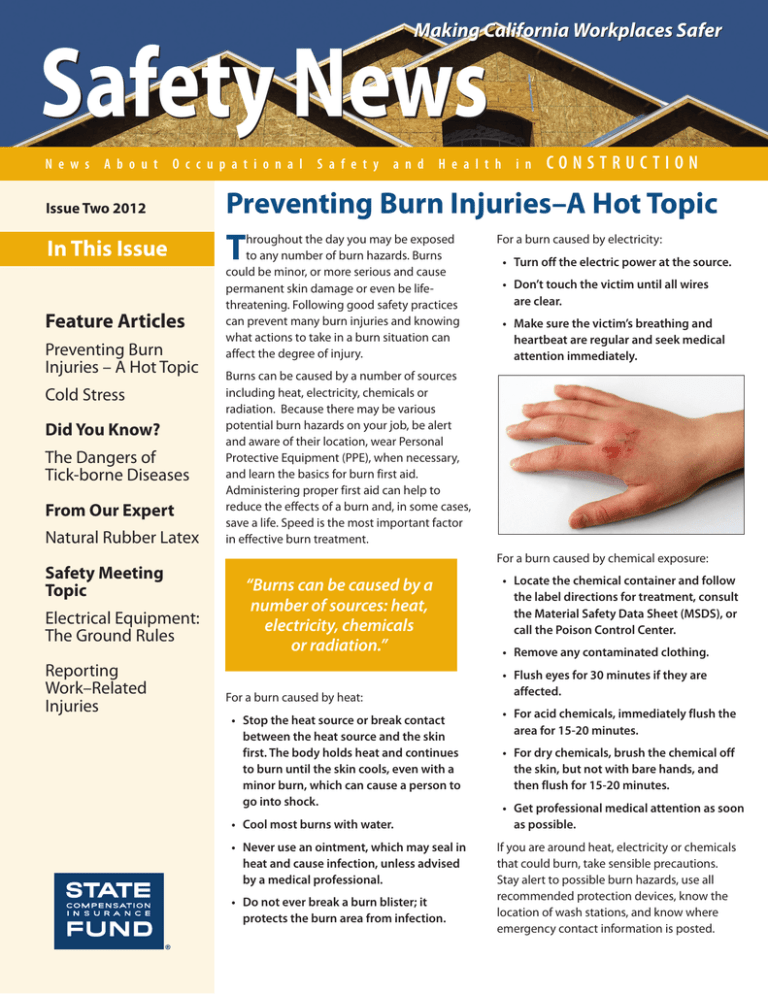
Making California Workplaces Safer Safety News N e w s A b o u t O c c u p a t i o n a l S a f e t y a n d H e a l t h i n CONSTRUCTION Issue Two 2012 Preventing Burn Injuries–A Hot Topic In This Issue T Feature Articles Preventing Burn Injuries – A Hot Topic Cold Stress Did You Know? The Dangers of Tick-borne Diseases From Our Expert Natural Rubber Latex Safety Meeting Topic Electrical Equipment: The Ground Rules Reporting Work–Related Injuries hroughout the day you may be exposed to any number of burn hazards. Burns could be minor, or more serious and cause permanent skin damage or even be lifethreatening. Following good safety practices can prevent many burn injuries and knowing what actions to take in a burn situation can affect the degree of injury. For a burn caused by electricity: • Turnofftheelectricpoweratthesource. • Don’ttouchthevictimuntilallwires areclear. • Makesurethevictim’sbreathingand heartbeatareregularandseekmedical attentionimmediately. Burns can be caused by a number of sources including heat, electricity, chemicals or radiation. Because there may be various potential burn hazards on your job, be alert and aware of their location, wear Personal Protective Equipment (PPE), when necessary, and learn the basics for burn first aid. Administering proper first aid can help to reduce the effects of a burn and, in some cases, save a life. Speed is the most important factor in effective burn treatment. For a burn caused by chemical exposure: “Burns can be caused by a number of sources: heat, electricity, chemicals or radiation.” For a burn caused by heat: • Stoptheheatsourceorbreakcontact betweentheheatsourceandtheskin first.Thebodyholdsheatandcontinues toburnuntiltheskincools,evenwitha minorburn,whichcancauseapersonto gointoshock. • Coolmostburnswithwater. • Neveruseanointment,whichmaysealin heatandcauseinfection,unlessadvised byamedicalprofessional. • Donoteverbreakaburnblister;it protectstheburnareafrominfection. • Locatethechemicalcontainerandfollow thelabeldirectionsfortreatment,consult theMaterialSafetyDataSheet(MSDS),or callthePoisonControlCenter. • Removeanycontaminatedclothing. • Flusheyesfor30minutesiftheyare affected. • Foracidchemicals,immediatelyflushthe areafor15-20minutes. • For dry chemicals, brush the chemical off the skin, but not with bare hands, and then flush for 15-20 minutes. • Get professional medical attention as soon as possible. If you are around heat, electricity or chemicals that could burn, take sensible precautions. Stay alert to possible burn hazards, use all recommended protection devices, know the location of wash stations, and know where emergency contact information is posted. Safety News State Compensation Insurance Fund Cold Stress W orking in cold conditions can lead to a potentially dangerous condition called cold stress. You can get cold stress when working outdoors on a cold day; in a refrigerated room; in an unheated building; in cold water, rain, or snow; or while handling cold objects or materials. When your body loses the ability to maintain its normal temperature, your body temperature lowers and hazardous effects of cold on the body could result in dehydration, numbness, shivering, frostbite, immersion foot (trench foot), and hypothermia. Issue Two 2012 How can you recognize cold stress? Shivering is your body’s response to cold stress and serves as a protection mechanism by increasing the rate of metabolism. Constant shivering, lethargy and confusion are initial signs of hypothermia. If you notice a drop in your manual dexterity, local cold stress may be occurring which could result in safety hazards to you and coworkers. If you work where conditions can get cold or wet, remember these tips: Cold, wind, and water are the three major factors of hypothermia because they all draw heat from the body. Other factors that make you susceptible to hypothermia include age, poor physical condition, illness, the use of alcohol or certain medications, and fatigue. The effects of hypothermia range from mild to severe. A severe case of hypothermia can cause permanent damage to your heart and other vital organs, or can result in death. • Dressproperly-Clothingisyour bestprotectionagainstcoldstress orhypothermia.Thegreatestlossof bodyheatoccursthroughthehead,so wearahatorcapandseverallayersof loose-fittingclothingaswellasboots orwarmshoeswithsocks. • Stay dry - Put on rain gear before you get wet and wool clothing before you start shivering. Also, sweating from overexertion can cause you to lose body heat more quickly. • Be aware of the cold and the wind Prepare for sudden weather changes with woolens, raingear, or tarps. • Drinkfluidsandeathigh-energy snacks-Snacksprovidecaloriesto producebodyheatandliquidshelp regulatebodytemperatures. • End exposure - If you can’t stay warm and dry, get out of the cold or wet environment. By recognizing early symptoms and taking suggested precautions, you can minimize the potential for cold stress. Did You Know? The Dangers of Tick-borne Diseases T icks are commonly found in worksites with woods, bushes, high grass, or leaf litter; ticks are a carrier of a number of serious diseases, such as Southern Tick-Associated Rash Illness (STARI), Rocky Mountain spotted fever (RMSF), Ehrlichiosis, Tularemia and most commonly Lyme disease with more than 22,500 confirmed and 7,500 probable cases in 2010 alone. Outdoor workers at risk include those in construction, landscaping, forestry, land surveying, farming, railroads, utility line work, park and wildlife management, and other outdoor work. Tick-borne diseases are diagnosed based on symptoms that are commonly associated with a tick-borne illness, such as: • Body/muscle aches • Joint pain • Fever • Rash • Headaches • Stiff neck • Fatigue • Facial paralysis Employers should educate their workers on: • Howtick-borne diseasesarespread. • The risks of exposure and infection. • The importance of the timely reporting of workplace illnesses and injuries right away. • Wearing light-colored long-sleeved shirts, long pants, socks, and hats. • Insect repellents (containing 20% to 30% DEET) to use on their skin and clothing for protection. For further information, refer to the Centers for Disease Control and Prevention (CDC) website on tick-borne diseases: http://www.cdc.gov/niosh/topics/tick-borne/ Safety News State Compensation Insurance Fund Issue Two 2012 From Our Expert Natural Rubber Latex N atural rubber latex is found in a wide variety of products such as balloons, rubber bands, and bandages. In the workplace, it is most commonly found in latex gloves. Many medical devices also contain latex. Dermatitis can also occur in latex glove wearers. Irritant contact dermatitis is a nonallergic reaction to the gloves or powder. Chemical sensitivity dermatitis is a reaction to one or more of the many chemicals added to latex during processing and manufacturing. “Those with regular exposure to latex gloves and other products containing latex may develop an allergic reaction…” The proteins in latex are allergens. Most people who encounter latex in consumer products do not develop an allergy to latex, but some workers are at risk. Those with regular exposure to latex gloves and other products containing latex may develop an allergic reaction. The more frequent the exposure, the greater the risk. Workers with other allergic conditions (such as hay fever) are at increased risk. Likewise people with dry, broken, or abraded skin are at increased risk. Latex allergy can be associated with allergies to certain foods, such as avocados, potatoes, bananas, tomatoes, chestnuts, kiwi fruits, and papayas. To prevent latex allergy, use latex-free gloves. If this is not possible, choose powder-free latex gloves with reducedprotein content. Wash hands with mild soap and water and dry thoroughly after removing gloves. Keep hands moisturized to minimize cracks and irritation. Once a worker becomes allergic to latex, special precautions are needed to prevent exposures during work as well as during medical or dental care. Symptoms of latex allergy include: • Skinrashes,hives,flushing,anditching • Nasal,eye,orsinusirritation • Shortness of breath, wheezing, or asthma • Shock (rarely) Symptoms can begin within minutes of exposure, or they can be substantially delayed. These symptoms can be serious, even life-threatening. Routes of exposure include skin contact and inhalation. Inhalation occurs when latex proteins attach themselves to the powder used in some gloves and become airborne. This is especially a problem when changing gloves. For more information on latex allergy and its prevention, visit the National Institute for Occupational Safety and Health (NIOSH) website at www.cdc.gov. State Fund Industrial Hygiene Unit Safety News State Compensation Insurance Fund Safety Meeting Topic Electrical Equipment: The Ground Rules I “Always read and follow operating instructions carefully before you connect and use items.” When disconnecting an electrical item from an outlet, firmly grip the plug, not the cord. Unplug electrical products, tools, and equipment when not in use. Electricity is always present in plugged-in equipment even when the switch is in the “off” position. So make sure to remove the plug from the receptacle outlet before you inspect, clean, or fix any electrical product. Topic Review Instructor ___________________________ Date _______________________________ Location ___________________________ Attended by 1. _____________________________________ 2. _____________________________________ n the course of your workday you probably use a variety of electrical products. You may touch many electrically-charged items without even considering the dangers. Keep the following general safety information in mind when handling electrical items. Always read and follow operating instructions carefully before you connect and use items. Electric plugs should only be inserted into outlets having the same slot or blade pattern, unless proper adapters are used. Do not force a plug into an outlet or alter it by bending, twisting, or removing its blades. A loose plug in an outlet can overheat and a fire may result—replace the plug, the outlet, or both, if necessary. Issue Two 2012 3. _____________________________________ 4. _____________________________________ 5. _____________________________________ 6. _____________________________________ 7. _____________________________________ 8. _____________________________________ 9. _____________________________________ Never touch an electrical item, tool, on-off switch, light fixture, or outlet when your hands are wet or if you’re standing on a wet or damp surface. Water getting on or into an electrical device can create a short circuit. If you come into contact with the shortcircuited device, you become the ground and the electricity will travel through your body to complete the circuit, resulting in a severe shock, burn, or fatal injury. If you notice signs of over-loaded circuits— such as flickering or dimming of lights, tripped circuit breakers, blown fuses, or if parts of the equipment, the connecting cords, or the outlet are warm to the touch—notify a licensed electrician or your company’s repair department of the problem. If you know how to safely do so, turn off the power at the main circuit until the problem is properly resolved. 10. _____________________________________ 11. _____________________________________ 12. _____________________________________ Safety Recommendations _____________________________________ _____________________________________ _____________________________________ _____________________________________ _____________________________________ _____________________________________ _____________________________________ _____________________________________ _____________________________________ _____________________________________ _____________________________________ _____________________________________ Reporting Work–Related Injuries State Fund’s Customer Service Center 888-STATEFUND (888-782-8338) is available 24 hours a day, 7 days a week for policyholders to report injuries as soon as they occur. Agents will do the necessary paperwork to get the claim started and refer the injured worker to the designated physician or provider. Within eight hours of any serious illness or injury (requiring hospitalization over 24 hours, other than for medical observation or where there is permanent employee disfiguration) or death occurring in the workplace or in connection with employment, employers must report the incident to the Division of Occupational Safety and Health. Safety News State Compensation Insurance Fund Temas de Seguridad Equipo eléctrico: Las reglas básicas Issue Two 2012 Revisión Del Tema Instructor ___________________________ Fecha ______________________________ Ubicación ___________________________ Asistente(s) 1. _____________________________________ E n el curso de su día de trabajo usted probablemente utiliza una diversidad de productos eléctricos. Quizá pueda hacer contacto con muchos artículos con carga eléctrica sin incluso darse cuenta de los peligros. Tenga en mente la información de seguridad general siguiente al manipular artículos eléctricos. 2. _____________________________________ Siempre lea y siga las instrucciones de operación cuidadosamente antes de conectar y utilizar los artículos. Los enchufes eléctricos únicamente deben introducirse en los tomacorrientes que tengan el mismo patrón de ranuras o patillas, a menos que se utilicen adaptadores apropiados. No fuerce el ingreso de un enchufe en un tomacorriente ni lo modifique doblando, torciendo o retirando sus patillas. Un enchufe flojo en un tomacorriente puede sobrecalentarse y causar un incendio; si es necesario, cambie el enchufe, el tomacorriente o ambos. 8. _____________________________________ “Siempre lea y siga las instrucciones de operación cuidadosamente antes de conectar y utilizar los artículos.” Al desconectar un artículo eléctrico de un tomacorriente, sujete firmemente el enchufe, no el cordón. Cuando no estén en uso, desenchufe los productos, las herramientas y los equipos eléctricos. La electricidad está siempre presente en el equipo conectado, incluso cuando el interruptor está en la posición de apagado “OFF”. Así que asegúrese de retirar el enchufe del tomacorriente del receptáculo antes de inspeccionar, limpiar o arreglar cualquier producto eléctrico. 3. _____________________________________ 4. _____________________________________ 5. _____________________________________ 6. _____________________________________ 7. _____________________________________ 9. _____________________________________ Nunca toque un artículo eléctrico, una herramienta, un interruptor de encendidoapagado, una lámpara o un tomacorriente cuando sus manos estén mojadas o si usted se encuentra en una superficie mojada o húmeda. El agua que cae o penetra en un dispositivo eléctrico puede crear un cortocircuito. Si usted entra en contacto con el dispositivo cortocircuitado, usted se convierte en la conexión a tierra y la electricidad viajará a través de su cuerpo para completar el circuito, dando por resultado una descarga fuerte, quemaduras o lesiones fatales. Si observa signos de circuitos sobrecargados, por ejemplo, luces parpadeantes o atenuadas, disyuntores disparados, fusibles quemados; o si los componentes del equipo, los cordones de conexión, o el tomacorriente se sienten calientes al tacto, notifique el problema a un electricista autorizado o al departamento de reparaciones de su empresa. Si usted sabe cómo hacerlo de manera segura, desconecte la alimentación eléctrica en el disyuntor principal hasta que el problema esté resuelto. 10. _____________________________________ 11. _____________________________________ 12. _____________________________________ Recomendaciones de seguridad _____________________________________ _____________________________________ _____________________________________ _____________________________________ _____________________________________ _____________________________________ _____________________________________ _____________________________________ _____________________________________ _____________________________________ _____________________________________ _____________________________________ _____________________________________ _____________________________________ This Construction Safety News is produced by the Corporate Communications Department of State Fund to assist clients in their loss control efforts. Information or recommendations contained in this publication were obtained from sources b­elieved to be reliable at the date of publication. Information is only advisory and does not presume to be exhaustive or inclusive of all workplace hazards or situations. Permission to reprint articles subject to approval by State Compensation Insurance Fund. Published by State Compensation Insurance Fund’s Corporate Communications Department. © State Compensation Insurance Fund 2012
